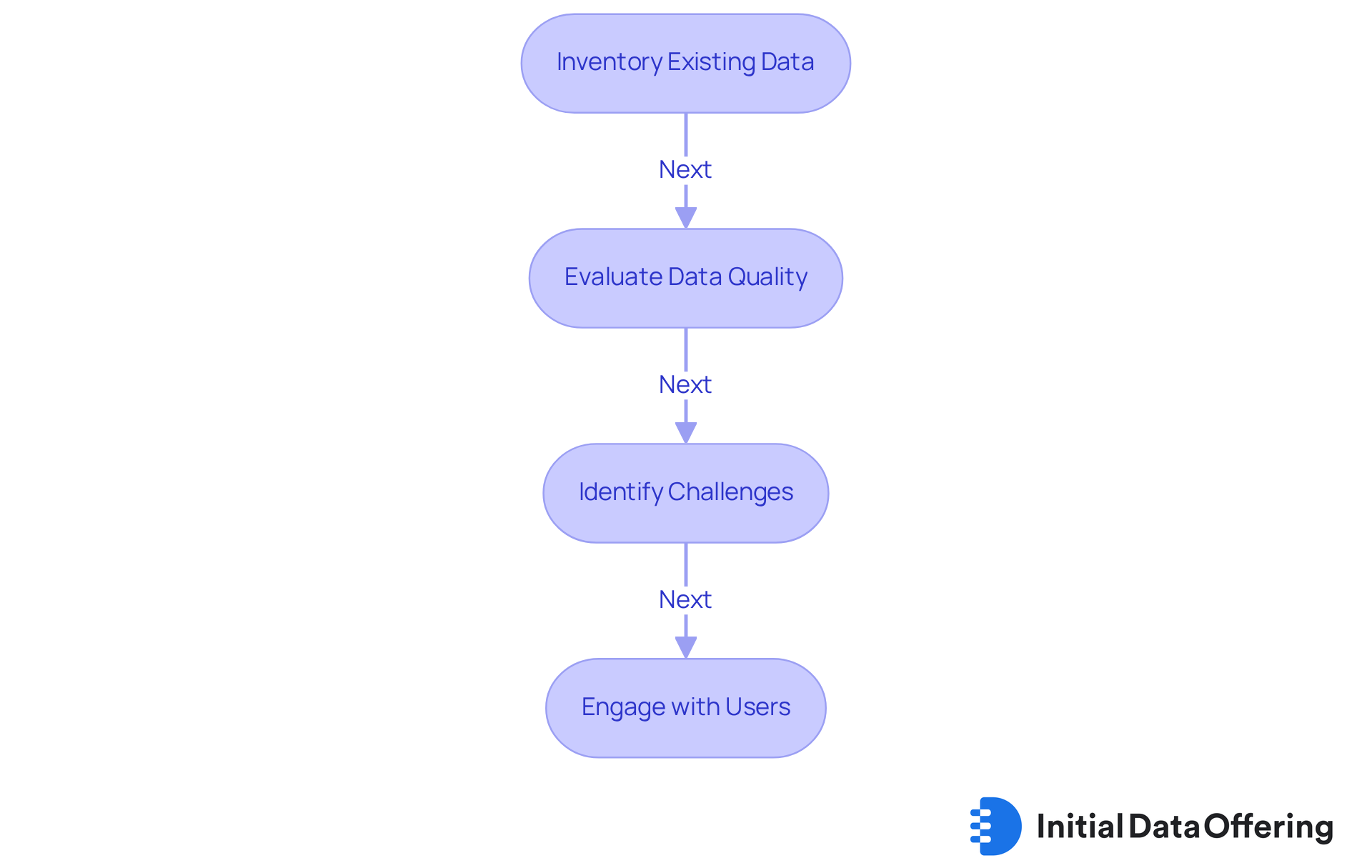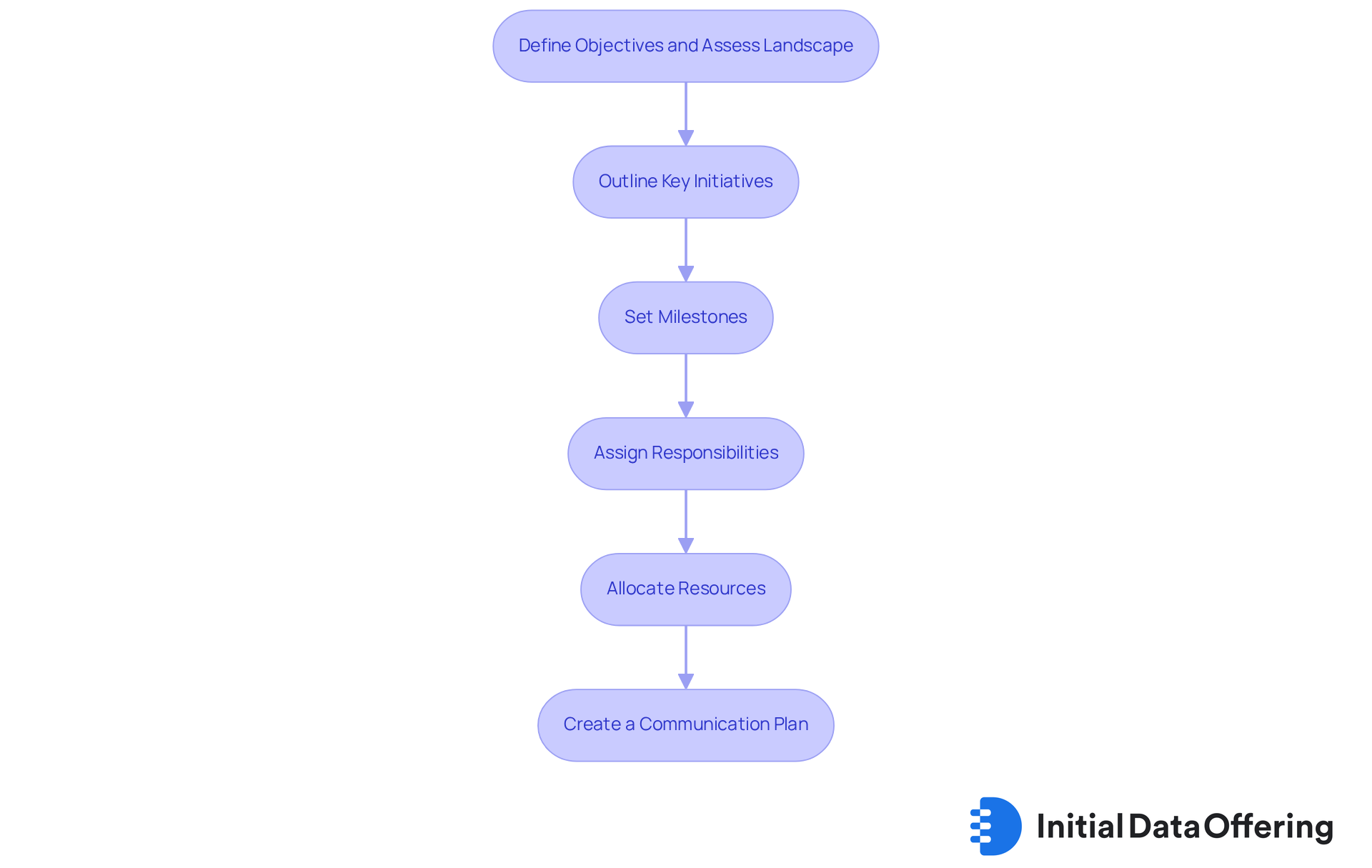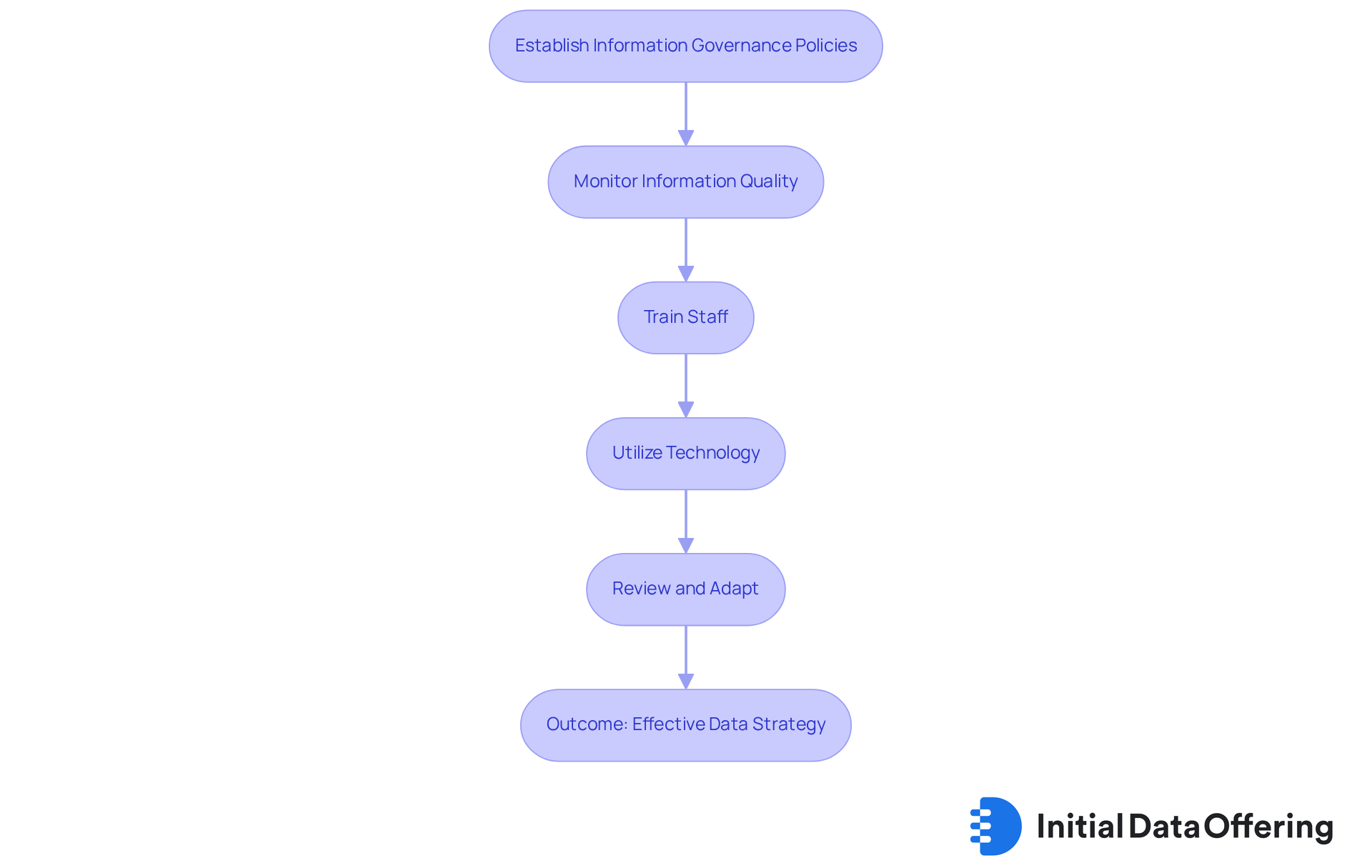Create Your Data Strategy Roadmap in 4 Simple Steps

Create Your Data Strategy Roadmap in 4 Simple Steps
Overview
Creating a data strategy roadmap is essential for any organization aiming to leverage data effectively. Start by defining clear business objectives. This sets the foundation for aligning data initiatives with overall business goals. Next, assess the current data landscape to understand existing capabilities and gaps. This assessment is crucial for developing structured initiatives that address specific needs.
Implementing governance mechanisms is another key feature of a successful data strategy. These mechanisms ensure that data management practices are consistent and compliant with regulations. The advantages of such governance include improved data quality and enhanced stakeholder engagement. When organizations prioritize quality data management, they not only meet compliance standards but also foster trust among stakeholders.
Regularly reviewing progress against defined objectives is vital. This practice allows organizations to adapt their strategies based on evolving business needs and data insights. Consider how often your organization evaluates its data initiatives. Are you making the most of your data? By aligning data goals with business aims, organizations can significantly enhance their effectiveness and decision-making capabilities.
In summary, a well-defined data strategy roadmap not only clarifies objectives but also drives organizational success. By focusing on quality data management and stakeholder engagement, businesses can unlock the full potential of their data assets.
Introduction
Crafting a data strategy roadmap is essential for organizations aiming to leverage their data effectively in a rapidly evolving digital landscape. Many companies struggle to align their information strategies with business objectives, making a clear, structured approach more critical than ever. This article outlines a four-step process that clarifies how to define objectives and assess current data landscapes. It also addresses the challenges organizations face in implementing effective governance mechanisms.
How can businesses ensure their data strategies not only meet immediate needs but also adapt to future demands? By understanding the features of a well-defined data strategy, organizations can gain significant advantages. These include:
- Improved decision-making
- Enhanced operational efficiency
- The ability to respond swiftly to market changes
Ultimately, a robust data strategy roadmap benefits organizations by positioning them for long-term success in a data-driven world.
Define Your Data Strategy Objectives
To effectively craft your data strategy, start by clearly defining your objectives through the following steps:
-
Identify Business Objectives: Align your information approach with overarching business goals. Are you focused on improving customer insights, enhancing operational efficiency, or driving innovation? It's noteworthy that only 39% of companies report their information strategy is completely in sync with business goals, highlighting the need for precise alignment.
-
Set Specific Objectives: Use the SMART criteria—Specific, Measurable, Achievable, Relevant, Time-bound—to create clear objectives. For example, aim to 'increase customer retention by 15% over the next year through targeted data analysis.' Remarkably, 83% of companies that implement SMART criteria see improved clarity and performance in their goal-setting processes. As John Spens points out, clear targets enable tracking real impact, not just technical progress.
-
Engage Stakeholders: Involve key stakeholders from various departments to gather diverse perspectives, ensuring that the objectives reflect the needs of the entire organization. This collaborative approach fosters a sense of ownership and commitment across teams.
-
Document Your Objectives: Create a formal document detailing your goals to serve as a reference throughout the planning process. Regularly reviewing these goals—at least quarterly—can increase the likelihood of achieving them by 31% compared to those who do not. Additionally, integrating robust information governance practices is essential for ensuring the precision and dependability of your information, which facilitates effective decision-making.
By clearly outlining your objectives, you create a roadmap for your data strategy that directs all subsequent actions in your information approach. This ultimately improves alignment with business goals and promotes organizational success.

Assess Current Data Landscape and Challenges
Begin by thoroughly assessing your current information environment to identify obstacles that could affect your strategy. Here’s how:
-
Inventory Existing Data: Start with a detailed catalog of all available datasets, including both internal and external sources. This should encompass various types of information—structured, unstructured, and semi-structured—to provide a well-rounded perspective. By understanding what data you have, you can better leverage it for strategic initiatives.
-
Evaluate Data Quality: Next, conduct a thorough evaluation of your datasets, focusing on critical attributes such as accuracy, completeness, and relevance. It’s essential to pinpoint any gaps or inconsistencies that might hinder your strategic goals. Research indicates that poor information quality can cost organizations an average of $15 million annually, with U.S. companies facing a staggering total of $3.1 trillion in losses each year due to subpar data quality. This underscores the importance of a meticulous assessment.
-
Identify Challenges: Recognize potential hurdles like information silos, lack of integration, and insufficient management frameworks that could obstruct your approach. Alarmingly, 25-30% of information is affected by quality issues each year, making it vital to tackle these challenges head-on. Additionally, organizations often face cultural resistance when implementing governance strategies, complicating efforts to improve information quality.
-
Engage with Users: Actively seek feedback from information users within your organization to understand their experiences and challenges regarding data access and usage. This engagement is crucial for grasping the practical implications of your information environment and fostering a culture driven by insights. As Jason Rushin points out, effective information governance requires strong leadership to align technical teams and business users around shared objectives.
This comprehensive evaluation will provide a clear picture of your starting point and highlight specific areas for improvement, ultimately guiding your data strategy roadmap. Consider leveraging tools like Alation Quality Control, which automate checks and flag issues early, to bolster your information quality management efforts.

Develop a Structured Data Strategy Roadmap
With your objectives defined and the current landscape assessed, it’s time to develop a structured roadmap:
-
Outline Key Initiatives: Identify key initiatives that will drive your information strategy based on your objectives and challenges. For example, introducing a new information management system or enhancing analytics capabilities can significantly boost operational efficiency and decision-making.
-
Set Milestones: Break down each initiative into smaller, manageable milestones with specific timelines. Research indicates that organizations typically establish five to seven milestones per initiative, which helps in monitoring progress and sustaining momentum. Quarterly reviews are recommended as the standard rhythm for updating the information strategy roadmap, ensuring it remains relevant and aligned with organizational capacity.
-
Assign Responsibilities: Designate team members or departments responsible for each initiative. Clear accountability is essential; studies show that organizations with defined roles experience a 10.3x return on investment compared to those lacking clarity in responsibilities. Assigning clear information stewardship roles across departments enhances governance.
-
Allocate Resources: Determine the resources (budget, tools, personnel) needed for each initiative and ensure their availability. For instance, financial services firms typically allocate about 10% of their revenue to technology transformation, highlighting the importance of resource commitment.
-
Create a Communication Plan: Develop a method for conveying progress and updates to stakeholders. Effective communication fosters transparency and engagement, which are crucial for maintaining support and alignment throughout the implementation process.
This data strategy roadmap serves as a guide for executing your information plan efficiently, ensuring that each initiative aligns with broader business goals and delivers measurable results. As Gowtham Chilakapati emphasizes, "An information approach should not exist separately—it must directly support business objectives.

Implement Governance and Control Mechanisms
To ensure the success of your data strategy, implementing robust governance and control mechanisms is crucial.
-
Establish Information Governance Policies: Start by creating comprehensive policies that clearly define ownership, access rights, and usage guidelines. These policies should align with legal and regulatory requirements, ensuring compliance and ethical information handling. This foundational step not only protects your organization but also fosters trust among stakeholders.
-
Monitor Information Quality: Next, implement ongoing processes for quality assessment and enhancement. Frequent evaluations are essential; research shows that organizations with effective information quality oversight can significantly reduce errors and improve decision-making. For instance, those that prioritize quality management often see a 30% increase in operational efficiency. Additionally, organizations with strong integration achieve 10.3 times the return on investment compared to those with poor integration. How does your organization currently assess information quality?
-
Train Staff: Providing thorough training for employees on information governance policies and best practices is vital. This promotes a culture of information responsibility and ensures staff are equipped to maintain information integrity. Studies indicate that organizations with a data-literate workforce are 5-15% more likely to reach their strategic goals. However, it’s important to recognize that 67% of analytics leaders cite organizational culture as the biggest barrier to becoming data-oriented, underscoring the need for effective change management.
-
Utilize Technology: Leverage advanced information management tools that support oversight efforts, such as lineage tracking and access controls. These technologies enhance data visibility and facilitate compliance with regulations like GDPR and HIPAA, which are critical in today’s data-driven landscape. Are you utilizing the right tools to support your governance efforts?
-
Review and Adapt: Finally, regularly assess and modify policies and control mechanisms to respond to evolving business needs and regulatory landscapes. Ongoing enhancement is crucial; organizations that frequently evaluate their management frameworks can achieve up to 10.3 times the return on investment compared to those with inadequate integration. Moreover, 46% of enterprises have a governance plan that exists but isn’t well understood, highlighting the importance of clear communication and training.
By establishing these mechanisms, you ensure that your data strategy remains effective, secure, and compliant over time, ultimately driving better business outcomes.

Conclusion
Creating an effective data strategy roadmap is essential for organizations looking to harness the power of their data. This roadmap features a structured approach that begins with:
- Defining clear objectives
- Assessing the current data landscape
- Developing a detailed plan
- Implementing robust governance mechanisms
The advantage of this method is that it ensures data initiatives align with overarching goals, positioning businesses for success. Ultimately, the benefit is a more strategic use of data that drives better decision-making and operational improvements.
Key insights from this guide highlight the importance of aligning data strategy with business objectives. Why is this alignment crucial? It allows organizations to assess data quality and challenges effectively, ensuring that they can navigate potential pitfalls. Establishing a comprehensive governance framework adds further value, as it enhances clarity, accountability, and operational efficiency. Engaging stakeholders, setting SMART goals, and regularly reviewing progress are vital steps that contribute to this alignment.
The significance of a well-crafted data strategy cannot be overstated. It fosters a culture of data-driven insights across the organization, enabling teams to make informed decisions. By prioritizing these steps, businesses can unlock the full potential of their data. How can your organization leverage these insights to remain competitive and agile in an increasingly data-centric world? The answer lies in embracing a structured approach to data strategy.
Frequently Asked Questions
What are the first steps to define a data strategy?
The first steps involve clearly defining your objectives by identifying business objectives, setting specific goals using the SMART criteria, engaging stakeholders, and documenting your objectives.
How can I align my data strategy with business goals?
You can align your data strategy with business goals by identifying overarching business objectives, such as improving customer insights, enhancing operational efficiency, or driving innovation, and ensuring your information approach supports these goals.
What does SMART criteria stand for?
SMART criteria stand for Specific, Measurable, Achievable, Relevant, and Time-bound, which are essential for creating clear and actionable objectives.
Why is it important to set specific objectives?
Setting specific objectives is important because it provides clarity and allows for tracking real impact, improving performance in goal-setting processes. Companies that implement SMART criteria often see better results.
How can stakeholder engagement benefit the data strategy?
Engaging stakeholders from various departments ensures diverse perspectives are considered, which helps reflect the needs of the entire organization and fosters a sense of ownership and commitment across teams.
What should be included in the documentation of objectives?
The documentation should detail your goals and serve as a reference throughout the planning process. Regular reviews of these goals can significantly increase the likelihood of achieving them.
How often should objectives be reviewed?
Objectives should be reviewed at least quarterly to enhance the chances of achieving them.
What role does information governance play in a data strategy?
Robust information governance practices are essential for ensuring the precision and dependability of your information, which facilitates effective decision-making within your data strategy.